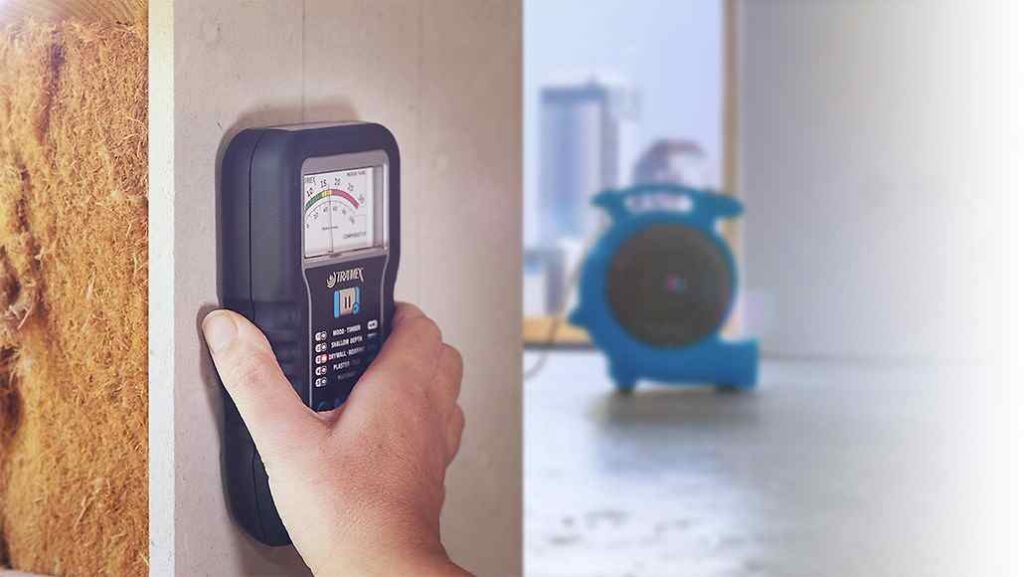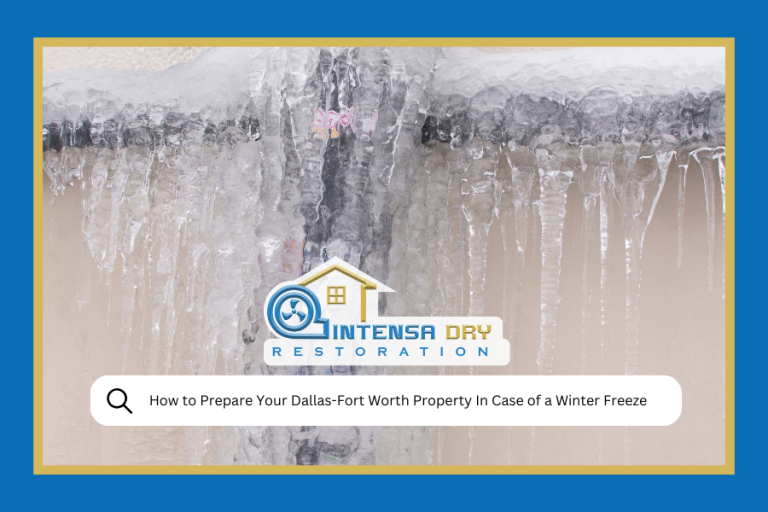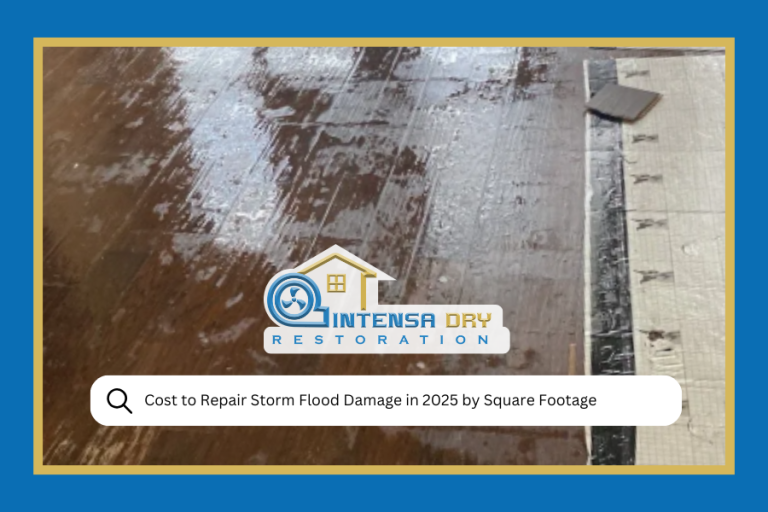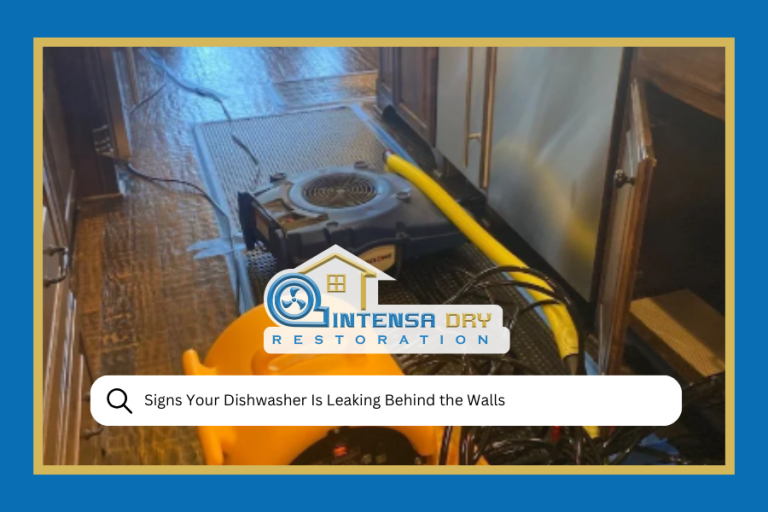Water damage in homes and commercial properties is more common than many people realize, especially in areas like Plano, where extreme weather and sudden leaks can often cause significant structural problems. When water damage occurs, a professional inspection is essential to understand the extent of the damage and create an effective restoration plan. During a water damage inspection, experts assess moisture levels, check for structural issues, and identify potential health hazards like mold. In this article, Intensa Dry will cover what to expect during a professional water damage inspection, including the key steps, methods, and tools used, as well as the benefits of having a trained inspector evaluate your property thoroughly.
What Is a Water Damage Inspection?
A water damage inspection is a comprehensive evaluation of your property to determine the impact of water intrusion. Trained inspectors examine various aspects of the building, including walls, ceilings, floors, and even hidden spaces like basements and attics. By assessing moisture content and signs of mold growth, they identify both visible and invisible damage. The primary goal is to understand the extent of the damage, assess safety risks, and outline necessary repairs. This inspection provides property owners with detailed insights into damage severity, helping them make informed decisions about repairs, insurance claims, and preventive measures for the future.
Why Is a Water Damage Inspection Important?
Water damage inspections are crucial for maintaining the health, safety, and integrity of a property. Untreated water damage can weaken a building’s structural components, leading to costly repairs and safety hazards. Additionally, standing water and excess moisture are breeding grounds for mold, which poses serious health risks. A professional inspection helps detect issues early, preventing further damage and reducing restoration costs. Insurance claims often require proof of water damage severity, and an official inspection report provides a solid foundation. By understanding the current condition of your property, you can take timely, effective action to restore it.
How Inspectors Identify and Assess Water Damage
Professional inspectors use various techniques and equipment to identify and assess water damage accurately. Infrared cameras detect temperature differences, revealing areas of trapped moisture even behind walls or ceilings. Moisture meters provide readings to measure the exact moisture levels in building materials, while hygrometers check indoor humidity. During an inspection, experts also visually assess areas for signs like stains, discoloration, and warping. Inspectors often use probes to measure the moisture in hardwood, carpet, or drywall, ensuring comprehensive analysis. By combining technology with their experience, inspectors can locate water-damaged areas, even those hidden from the naked eye.
Tools and Techniques Used in Water Damage Inspections
During a water damage inspection, professionals employ a range of tools and techniques designed to provide accurate, thorough assessments. Thermal imaging cameras are frequently used to identify moisture pockets behind surfaces without needing to remove drywall. Moisture meters and probes detect dampness levels in specific areas, while dehumidifiers and airflow monitors help assess ventilation and drying needs. Some experts use borescopes to check inside walls and crevices. This advanced toolkit ensures that inspectors don’t overlook hidden damage, allowing them to build an accurate damage profile. Armed with this information, they create effective, targeted restoration plans to address every affected area.

The Key Stages of a Water Damage Inspection
A water damage inspection typically follows several key stages. First, inspectors conduct a visual assessment, checking for visible signs like stains, discoloration, and odors. Next, they test for hidden moisture using specialized tools like moisture meters and infrared cameras. Inspectors then examine structural elements to ensure that walls, floors, and ceilings are sound. Finally, they record their findings, taking notes, photographs, and sometimes videos to document the extent of the damage. This multi-step process ensures a comprehensive evaluation, enabling inspectors to pinpoint areas requiring immediate attention and provide detailed information for insurance claims or restoration planning.
Common Areas of Inspection in Water-Damaged Properties
Inspectors typically focus on specific areas prone to water damage. Walls, floors, and ceilings are closely examined, especially around plumbing fixtures, windows, and exterior walls. Basements and crawl spaces often harbor hidden moisture, while attics can accumulate water from roof leaks. Inspectors also check HVAC systems and ductwork for moisture intrusion. Kitchens, bathrooms, and laundry rooms are high-priority areas due to their proximity to water sources. Inspectors may also assess wooden beams, insulation, and foundation elements, as water can compromise these materials over time. A thorough inspection covers each of these areas to ensure no damage goes unnoticed.
How Long Does a Water Damage Inspection Take?
The time required for a water damage inspection depends on the size of the property and the extent of the damage. For smaller properties with minor water issues, inspections may take an hour or less. Larger homes or commercial buildings with extensive damage, however, might require several hours. Complexity also plays a role; properties with multiple floors, hidden rooms, or areas with suspected mold growth may require additional time. A detailed inspection is crucial to ensure accurate findings, so inspectors may take extra time to verify readings and thoroughly document their findings, especially if insurance claims are involved.
What Happens After a Water Damage Inspection?
Following the inspection, the water damage inspector will compile a comprehensive report that outlines the extent of the damage, potential health hazards, and recommended repairs. This report often includes detailed photographs, moisture readings, and a clear description of affected areas. Property owners use this information to develop a restoration plan and submit any necessary insurance claims. In some cases, inspectors might refer you to specialists for mold remediation or structural repairs. By having this thorough report, property owners gain a clear roadmap to recovery, knowing exactly what repairs are needed to restore their property safely and effectively.
Benefits of Hiring a Professional for Water Damage Inspection
Hiring a professional for water damage inspection brings numerous advantages, starting with their expertise in spotting hidden damage. Trained inspectors know where to look for moisture, even in concealed areas, ensuring a comprehensive assessment. They use high-tech tools for accuracy and produce detailed reports that facilitate insurance claims. Moreover, professionals provide valuable insights into preventive measures, helping property owners avoid future water issues. With a clear understanding of the damage, property owners can make informed decisions, potentially saving time and money on repairs. A professional inspection ultimately provides peace of mind, knowing the problem is thoroughly addressed.
How to Choose the Right Water Damage Inspection Service

Selecting a reliable water damage inspection service in Plano requires research and consideration. Start by verifying certifications and licenses, which ensure the inspectors are trained and compliant with industry standards. Check customer reviews and ratings to gauge their reputation. Ask about the tools and techniques they use and if they provide comprehensive reports. It’s beneficial to choose a service with experience in your specific property type, as residential and commercial buildings have different needs. Ensure the company is responsive and provides clear estimates. By selecting a trusted service, you can ensure an accurate and thorough inspection.
Signs You May Need a Water Damage Inspection
If you’re unsure whether to schedule a water damage inspection, look for specific signs indicating moisture issues. Stains on walls, ceilings, or floors are telltale indicators of water leaks, while bubbling or peeling paint often signals trapped moisture. A musty odor in certain rooms is another warning sign, typically pointing to hidden mold growth. Warped wood, buckling floors, and unexpected increases in utility bills are additional red flags. If you hear dripping sounds without a clear source, it’s also wise to investigate. Recognizing these early warning signs can prompt timely action, allowing you to schedule an inspection before damage worsens.
How Water Damage Inspections Help with Insurance Claims
Water damage inspections play a critical role in filing successful insurance claims. Insurers require documentation to verify the extent and source of damage, and a professional inspection provides clear evidence through detailed reports, photographs, and moisture readings. Inspectors identify which areas are affected, the severity of damage, and potential causes, offering crucial information for claims adjusters. With a well-documented report, you’ll have accurate, reliable proof to support your claim, improving your chances of reimbursement. Many inspectors also have experience working with insurers, helping to expedite the process by offering information in a format that meets insurance company requirements.
What to Expect from the Restoration Process Post-Inspection
After a thorough water damage inspection, the restoration process can begin with a clear action plan. Restoration typically involves several steps: removing standing water, drying affected areas, dehumidifying, and sanitizing spaces. Specialized equipment like industrial-grade fans and dehumidifiers ensure quick drying to prevent mold growth. In cases of severe structural damage, repairs to drywall, flooring, and other materials may follow. Restoration professionals coordinate with inspectors to confirm all affected areas are addressed. Regular monitoring continues during this phase to check humidity levels, helping prevent further issues. The entire process restores the property to a safe, dry, and functional state.
FAQs
Q: How much does a water damage inspection typically cost in Plano?
A: The cost of a water damage inspection in Plano varies based on property size, damage severity, and inspection company. Expect to pay between $200 to $600. Some companies offer free inspections if you use their restoration services afterward. Always ask for a quote and inquire about what is included.
Q: How long does it take to receive the inspection report?
A: Most inspection companies provide the report within 24 to 48 hours after the inspection. However, complex cases or extensive properties might require additional time for thorough documentation. Many inspectors now offer digital reports, allowing you to receive them faster.
Q: Can water damage inspections detect mold issues?
A: Yes, water damage inspections often identify mold-prone areas and visible signs of mold growth. However, for a detailed mold assessment, a separate mold inspection may be recommended, especially if mold is widespread or deeply embedded in materials.
Q: What should I do if water damage is found?
A: If water damage is detected, work with a restoration service to address it promptly. Start by documenting the damage for insurance purposes. Then, discuss the inspector’s findings with a professional restoration team to establish a repair plan, starting with water extraction and drying to prevent mold growth.
Q: How can I prevent future water damage?
A: To prevent future water damage, conduct regular maintenance of plumbing and roofing, check for leaks, and ensure proper drainage around your property. Installing a sump pump, maintaining gutters, and using moisture detectors can also help protect your property from future water intrusion.
Q: Do I need an inspection if I only see minor water stains?
A: Yes, even minor water stains can indicate underlying moisture problems that might worsen over time. A professional inspection can determine whether the stain is a cosmetic issue or a symptom of hidden damage, saving you from future repair costs.
Conclusion
A professional water damage inspection is an essential step in safeguarding your property’s structure and health. By identifying both visible and hidden damage, inspectors help property owners in Plano address water issues before they escalate. The inspection provides an in-depth understanding of affected areas, offers insights for effective repairs, and simplifies the insurance claim process. With advanced tools and a methodical approach, professionals ensure no damage goes unnoticed, allowing for a smoother restoration process. Choosing a qualified inspection service ensures peace of mind and helps restore your property efficiently, leaving it safe, dry, and secure against future water-related issues.





